Mothers behind bars nurture relationships with visitors in this unusual prison garden
About half of incarcerated women in the United States are mothers to children under age 18. Natural spaces within a prison can help maintain their mother-child bonds.
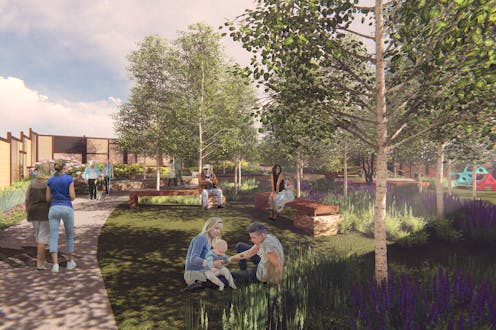
Leaves are rustling. You can hear the sound of children kicking a ball, plinking the keys of a toy xylophone. People are laughing and talking.
Are you picturing a prison? My colleagues and I did – and we turned these visions into reality. The garden and playscape we created at the Iowa Correctional Institution for Women (ICIW) is changing the way incarcerated women spend time with their children, family and friends.
“Home” is not a word typically associated with prison environments, but that’s one way respondents in our recent study described the new outdoor area. Our design-build team made up of Iowa State University design students and incarcerated women and staff at ICIW created a space where incarcerated women can forget their identity as inmates and step back into their roles as mothers or grandmothers, sisters or aunts.
Hard to maintain connections with home
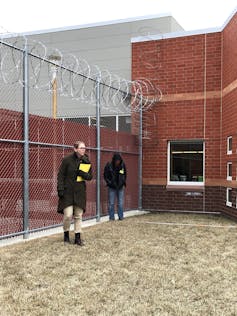
People living inside prisons must endure isolation, tight spaces, loss of identity and separation from loved ones. Prisons are typically stark and void of color and living plants. Visits from loved ones can ease this difficult situation, but prison visits are complicated.
Many incarcerated people find it difficult to maintain connections with loved ones, especially children. These bonds can be a critical component of successful reentry back to their home and community after release. Though often cold and condemning, the prison visiting room may be the place where mothers and children first face one another after the traumatic events that led to incarceration – with security officers and other incarcerated people and visitors within earshot.
And that’s only if children make the difficult trip. It is often financially and logistically impossible for those caring for the children of incarcerated parents to make a visit happen. Caregivers might be worried about the conditions they’d be bringing children into.
Why is this important? Because more than 5 million children in the U.S. have seen a parent sent to prison. Forty-eight percent of women in federal correctional facilities and 55% in state prisons are mothers of children under the age of 18. Children of incarcerated parents are at increased risk of themselves becoming incarcerated, struggling with mental health and performing poorly in school. They also tend to display behavioral issues and feelings of shame and abandonment.
When my students and I started working with the Iowa Correctional Institution for Women in 2011, our task was seemingly simple: beautify the grounds. The warden wanted calm inmates. These goals were linked – and I can happily say we’ve achieved both.
But from the start, one project felt most significant to me – creating a nurturing outdoor space where mothers could build and maintain those incredibly important relationships with their children.
Adding nature within prison walls
Research suggests that natural environments can help mitigate stress and offer other psychological benefits.
The original outdoor visiting space consisted of brick and razor wire. As landscape architects, my team used environmental psychology and therapeutic landscape theories to carefully design active and passive spaces surrounded by gardens. Our aim was to employ the benefits of nature to improve connections between an incarcerated individual and her loved ones.
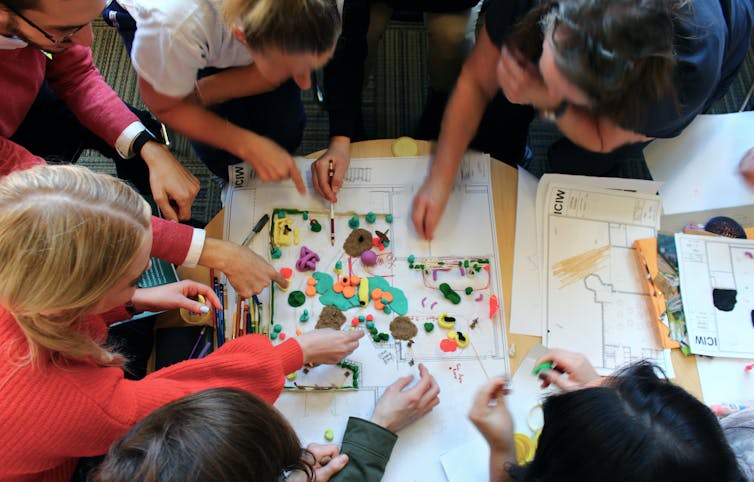
Through participatory design, we honored the needs and desires of the incarcerated women by including them as the most knowledgeable members of the design team. With pencils and play dough in hand, resident designers and their child visitors explicitly described what they wanted: a garden that felt and looked like home or a park.
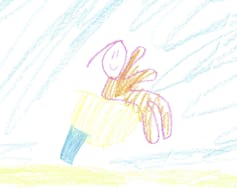
The finished garden includes a circular walk wide enough for two tricycles or wheelchairs to pass comfortably. Play equipment like the tulip spinners provide a fun way for kids to release energy and are a great conversation piece for observers. We installed more comfortable seating where residents and visitors can take advantage of the positive natural distractions of colorful plants and rustling Quaking Aspen leaves.
One Saturday afternoon, we watched as a family arrived to visit mom. The younger children embraced her with warm hugs while a teenager stayed silent with arms crossed. Mom gave him a little space as they walked to the garden and then began to talk.
Even though it was exactly what we hoped would happen in the garden, we watched in amazement as their body language changed from tense to accepting and they started talking together. The visit eventually ended with the warmth that every mother and child need from each other.
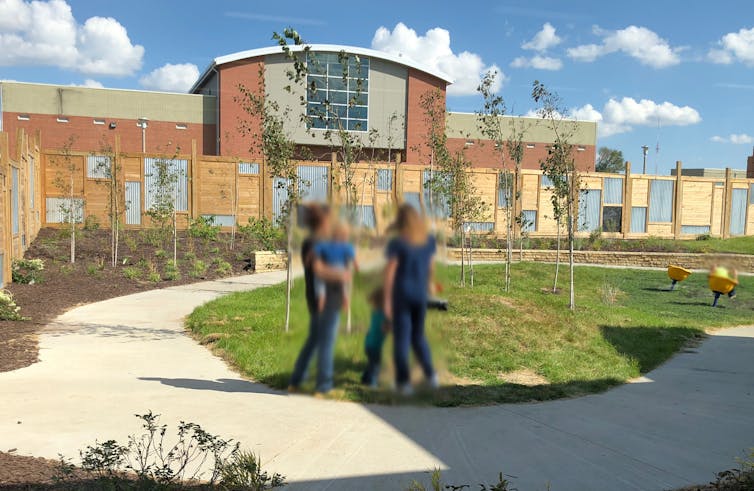
What moms and kids say about the new space
To learn more about the garden’s effect on incarcerated women and their visitors, my colleagues Barb Toews and Amy Wagenfeld conducted interviews and surveys with them in the garden itself. They told us that visits had changed in four important ways:
- More child-friendly: Visits are now more conducive to “kids being kids.”
- Improved emotional experience: Visits are less stressful or boring. Interviewees used words such as “cozy,” “calm” and “fun” to describe their experience in the garden.
- Home-like environment: The “backyard” feel to the garden facilitates natural play and conversations between the incarcerated women and their visitors.
- Improved parent-child relationship: Child visitors come more often, stay longer, enjoy better activities and improved quiet time. Overall the garden improved the quality of the time incarcerated women and their kids spent together.
People tend to support strengthening mother-child relationships, but I do sometimes hear critiques. Some argue that improving prison environments is a poor use of money – but the garden was supported by donors and the sweat equity of the ICIW women and our students. Others say that people just shouldn’t commit crimes, or that if a prison is too nice people will want to stay. But while the prison may indeed be the safest place many of these women have lived, they just want to go home. And I’d argue that healthy environments are a necessity, not a luxury.
Mothering is at once an extraordinary and challenging journey. I know this firsthand and I cannot imagine doing it from prison. Based on the requests for information and consultations I’ve received from around the world, many people, especially the newest generation of environmental designers, recognize these challenges and care about strengthening those mother-child bonds by changing prisons’ physical spaces.
[Deep knowledge, daily. Sign up for The Conversation’s newsletter.]
Julie Stevens has received funding from the Iowa Department of Corrections and The Wellmark Foundation. She is a member of the American Society of Landscape Architects and the Environmental Design Research Association.
Read These Next
Chile elects most right-wing leader since Pinochet – in line with regional drift, domestic tendency
José Antonio Kast, who has run for the presidency several times, successfully seized on widespread…
The ‘one chatbot per child’ model for AI in classrooms conflicts with what research shows: Learning
AI tutors are often held up as an ideal, but prioritizing individualized teaching can detract from the…
From civil disobedience to networked whistleblowing: What national security truth-tellers reveal in
Whistleblowers’ stories show how accountability is shifting from formal legal institutions to solidarity…






